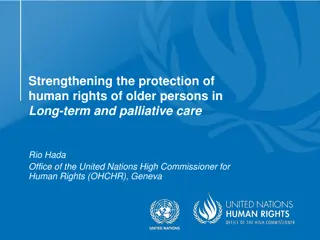Long-Term Impacts of Schooling Disruptions in Kuwait
Analysis of Kuwait's Civil Service Payroll Data reveals that schooling disruptions, particularly during the Gulf War, have resulted in long-term consequences on individuals' education and earnings. Men and women of schooling age during the war experience lower earnings for each year of school lost, with students in lower grades facing higher wage losses. The estimated lifetime income lost for students affected by such disruptions today is substantial. The study also showcases the historical background of the Gulf War's impact on schooling in Kuwait, emphasizing the importance of addressing such disruptions for future generations.
Download Presentation

Please find below an Image/Link to download the presentation.
The content on the website is provided AS IS for your information and personal use only. It may not be sold, licensed, or shared on other websites without obtaining consent from the author.If you encounter any issues during the download, it is possible that the publisher has removed the file from their server.
You are allowed to download the files provided on this website for personal or commercial use, subject to the condition that they are used lawfully. All files are the property of their respective owners.
The content on the website is provided AS IS for your information and personal use only. It may not be sold, licensed, or shared on other websites without obtaining consent from the author.
E N D
Presentation Transcript
The Long Shadow of Short-Term Schooling Disruption Analysis of Kuwait s Civil Service Payroll Data Source: The U.S. National Archives & David Mcleod
Our team Mohamed Ihsan Ajwad Senior Economist (HMNSP) World Bank, Washington DC (Social protection & labor economics) Simon Bilo Consultant (HMNSP) World Bank, Washington DC (Macroeconomics & labor economics) Ebtesam Alansari Assistant Professor Public Authority for Applied Education and Training, Kuwait City (Development & labor economics) Lama Alhumaidan Assistant Professor Public Authority for Applied Education and Training, Kuwait City (Development & labor economics) Faleh AlRashidi Advisor The Secretary-General Office General-Secretariat of The Supreme Council for Planning and Development, Kuwait
What are the long-term impacts of schooling disruptions? What are the public sector returns to schooling in Kuwait? Research questions What are the impacts of schooling disruption by levels of schooling?
Key message: Schooling disruptions lead to long term impacts People of school age during the Gulf War have fewer years schooling than people who were too young to attend school during the war Among people of schooling age during the Gulf War: Men earn 5.6% less on average for each year of school attainment lost Women earn 6.8% less on average for each year of school attainment lost Students who were in lower grades during the Gulf War tend to suffer a greater percentage wage loss for each year of schooling attainment lost If an identical shock disrupted elementary school students today, the estimated present value of lifetime income lost would be ~$21K for female students ~$41K for male students
Roadmap HISTORICAL BACKGROUND LABOR MARKET DATA METHODOLOGY RESULTS CONCLUSION Source: The U.S. National Archives & Perry Heimer
Historical background Iraqi invasion and the Gulf War August 2, 1990 February 26, 1991 Effects of the Gulf War on schooling in Kuwait Some students were abroad and some in Kuwait Formal schooling was suspended and infrastructure destroyed/damaged Physical and psychological impacts on students Post war: accelerated (catchup) learning in 1991/92 Gross school enrolments in Kuwait (%) Source: World Bank, World Development Indicators 120 100 80 60 % 40 20 0 1971 1973 1975 1977 1979 1981 1983 1985 1987 1989 1991 1993 1995 1997 1999 2001 2003 2005 2007 2009 2011 2013 2015 2017 Primary school enrollment Secondary school enrollment Tertiary school enrollment
Kuwaits labor market Kuwaitis are a minority in the labor market 2.9 million of workers, only 7.2% are Kuwaitis (~408K) Kuwaitis are a majority in the public sector 85% of all Kuwaiti workers are in the public sector 464K public sector workers, 74% are Kuwaitis (~345K) Majority of public sector workers employed through the Civil Service Commission
Data Source: Kuwait Civil Service Commission Date collected: June/July 2019 Type: cross-section # observations (pre-processing): ~341K Includes ~262K Kuwaiti nationals, ~64% of all employed Kuwaitis Notable variables: Employer, Age, Highest achieved education level, Compensation (including social benefits), Years of service, Marital status, # of children (if receiving benefits) Keep only the age cohorts that likely graduated Keep people born before March-16-1992 Remove the age cohorts that reached the retirement age Remove men born before 1966 and women born before 1971
Methodology Our starting point the human capital model ??= ? + ?1? + ?? + ??, where yi natural log of income S educational attainment (years of schooling) X vector of other relevant characteristics (years of experience, distinct compensation categories) i error term Omitted variables such as ability are likely correlated with S Estimates of private returns to schooling ( 1) are then biased and inconsistent
Methodology: The omitted variable bias People with more schooling tend to earn more Is it because More schooling causes higher income? OR higher ability causes more schooling AND higher income? Problem: How to identify the causal effect of schooling on wages when we cannot measure the ability? Causation & correlation Years of schooling Wage Unobserved ability
Methodology: Using Gulf War exposure to address the omitted variable bias Solution to the OVB: Random assignment of years of schooling The Gulf War is a natural experiment that provides such random assignment It affects schooling, not ability We can identify the causality between schooling and wages Random shock identifies the causality Years of schooling Wage Unobserved ability
Methodology: The models Models reflect the gender-based difference in compensation For women ln ????? = ? + ?1?? ????+ ?2????+ ?3???? For men ln ????? = ? + ?1?? ????+ ?2????+ ?3???? ? 2+ ?=1 ??? ?????+ ?? ? 2+ ?4????????+ ?=1 ??? ?????+??
Why the Gulf War exposure seems like a reasonable instrument Of schooling age during the war Of schooling age during the war Kuwaiti civil servants average years of schooling in 2019, grouped by their estimated education group in 1990
Results: 2SLS estimates of returns to schooling, full sample, by gender (1) (2) (3) (4) Women (single instrument) Women (multiple instruments) Men (single instrument) Men (multiple instruments) 0.0683*** 0.0680*** 0.0504*** 0.0564*** Years of schooling (0.000974) (0.000880) (0.00237) (0.00175) 0.00985*** 0.00989*** 0.0201*** 0.0202*** Years of service (0.000463) (0.000466) (0.000404) (0.000402) 0.000655*** 0.000654*** 0.0000441*** 0.0000343** Years of service squared (0.0000188) (0.0000189) (0.0000131) (0.0000128) 5.800*** 5.804*** 6.149*** 6.068*** Constant (0.0130) (0.0117) (0.0324) (0.0240) Controlling for number of children Yes Yes Yes Yes Controlling for the marital status No No Yes Yes Observations 123905 123905 79377 79377 R-squared 0.617 0.617 0.604 0.614 Dependent variable: the natural log of net wages. Single instrument: whether the person was of schooling age during the Gulf War (columns 1 and 3). Multiple instrument: which schooling grade level the person was during the war (columns 2 and 4).
Disaggregate 2SLS results for women: years of schooling instrumented by the age of exposure to the shock (1) (2) (3) (4) Elementary school Middle school Secondary school College 0.0858*** 0.0745*** 0.0655*** 0.0645*** Years of schooling (0.00183) (0.00161) (0.00130) (0.00176) 0.0104*** 0.0113*** 0.0160*** 0.0183*** Years of service (0.000638) (0.000688) (0.000603) (0.000612) 0.000677*** 0.000634*** 0.000415*** 0.000360*** Years of service squared (0.0000347) (0.0000321) (0.0000247) (0.0000249) 5.537*** 5.700*** 5.813*** 5.815*** Constant (0.0258) (0.0222) (0.0179) (0.0246) Controlling for # of children Yes Yes Yes Yes Observations 78684 74181 69117 58787 R-squared Dependent variable: the natural log of net wages. Instrument: whether the person was of schooling age during the Gulf War. 0.560 0.572 0.587 0.558
Disaggregate 2SLS results for men: years of schooling instrumented by the age of exposure to the shock (1) (2) (3) (4) (5) Elementary school Middle school Secondary school College Graduate school 0.0876*** 0.0941*** 0.0733*** 0.0545*** 0.0280*** Years of schooling (0.00600) (0.00553) (0.00314) (0.00331) (0.00585) 0.0172*** 0.0209*** 0.0234*** 0.0260*** 0.0287*** Years of service (0.00153) (0.00111) (0.000764) (0.000676) (0.000722) 0.000385*** 0.000104* -0.0000913** -0.000157*** -0.000186*** Years of service squared (0.0000797) (0.0000518) (0.0000289) (0.0000223) (0.0000215) 5.631*** 5.532*** 5.816*** 6.069*** 6.427*** Constant (0.0882) (0.0802) (0.0451) (0.0473) (0.0830) Controlling for # of children Yes Yes Yes Yes Yes Controlling for marit. status Yes Yes Yes Yes Yes Observations 44277 42025 40090 37892 34441 R-squared Dependent variable: the natural log of net wages. Instrument: whether the person was of schooling age during the Gulf War. 0.495 0.517 0.568 0.582 0.495
Assessing the long-term damage of schooling disruption: compensation change Women Men Exposed to the war in: Estimated returns to year of schooling Estimated change in the years of schooling Change in annual compensation Estimated returns to year of schooling Estimated change in the years of schooling Change in annual compensation -3.4% -4.3% Elementary school 0.0858 -0.393 0.0876 -0.496 -4.3% -4.2% Middle school 0.0745 -0.578 0.0941 -0.448 -5.1% -6.0% Secondary school 0.0655 -0.786 0.0733 -0.818 -5.8% -4.3% College 0.0645 -0.899 0.0545 -0.785 -2.3% Graduate school 0.0280 -0.816 Note: Women who were of the graduate school age during the Gulf War already reached their retirement age.
Assessing the long-term damage to schooling disruption: lifetime income loss Women Men Exposed to the war in: Elementary school Annual salary loss (US$) 1,609 Present value of lifetime loss (US$) 20,914 Annual salary loss (US$) 2,700 Present value of lifetime loss (US$) 40,674 Middle school 2,034 30,508 2,637 45,078 Secondary school 2,413 41,380 3,767 71,102 Underlying question: What would be the estimated cost related to schooling disruptions if the Gulf War shock happened today?
Limitations of the estimates While schooling disruptions likely had a big impact, we are not able to unpack the impact of schooling disruptions and damage that might have been caused by physical or psychological trauma on school-aged children We are unable to control for secular growth in schooling. The older the affected cohort, the lower the confidence in the results
Conclusion: COVID-19 schooling crisis in the light of our results There are similarities between the two episodes The damage might end up being long term Annual loss of income 2-6% is non-trivial Prospective income loss might differ across cohorts Timely high-quality data on schooling loss will be critical Distribution of the length of school closures during the pandemic up to March 2021 (Kuwait, 42 weeks of closures; source: UNESCO) Kuwait
Thank you For details, please see: Bilo, Simon; Ajwad, Mohamed Ihsan; Alansari, Ebtesam; Alhumaidan, Lama; AlRashidi, Faleh. 2021. The Long Shadow of Short-Term Schooling Disruption : Analysis of Kuwait's Civil Service Payroll Data. Policy Research Working Paper;No. 9641. World Bank, Washington, DC.






















